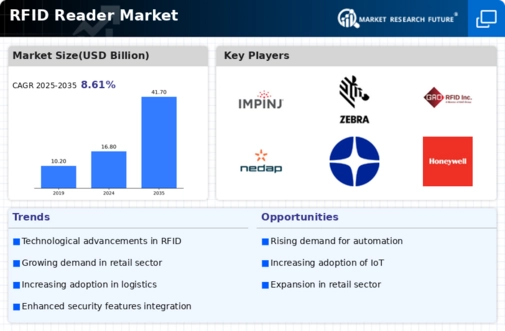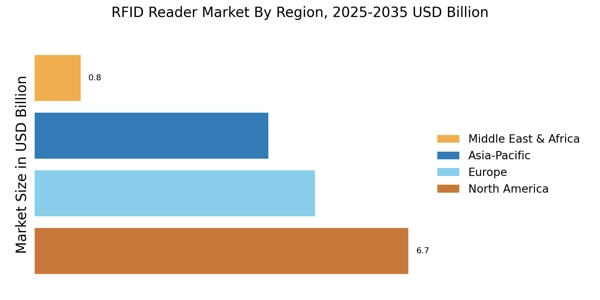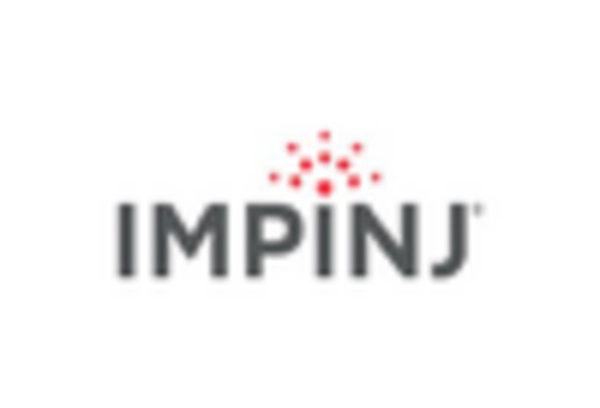Emerging Applications in Healthcare
The RFID Reader Market is expanding into emerging applications within the healthcare sector, where the need for accurate tracking and management of medical assets is becoming increasingly vital. RFID technology is being utilized for patient identification, medication management, and equipment tracking, thereby enhancing operational efficiency and patient safety. The adoption of RFID readers in healthcare settings is expected to grow as hospitals and clinics seek to minimize errors and improve workflow. With the healthcare industry projected to invest significantly in RFID solutions, the market for RFID readers in this sector is anticipated to reach approximately 3 billion dollars by 2026. This growth reflects the potential of RFID technology to transform healthcare operations and improve patient outcomes.
Growth of E-commerce and Retail Sectors
The RFID Reader Market is significantly benefiting from the growth of e-commerce and retail sectors. As online shopping continues to gain traction, retailers are increasingly adopting RFID technology to manage inventory more effectively and enhance customer experience. RFID readers enable retailers to track inventory levels in real-time, reduce stockouts, and improve order fulfillment processes. This is particularly crucial in the fast-paced e-commerce environment, where efficiency and accuracy are vital for customer satisfaction. Recent data suggests that the retail sector's investment in RFID technology is expected to exceed 5 billion dollars by 2025, highlighting the critical role of RFID readers in supporting the evolving landscape of retail and e-commerce.
Rising Demand for Automation in Industries
The RFID Reader Market is significantly influenced by the rising demand for automation across various industries. As businesses strive to enhance operational efficiency and reduce human error, the implementation of RFID technology has become a preferred solution. Industries such as retail, logistics, and manufacturing are increasingly adopting RFID readers to automate inventory tracking, asset management, and supply chain processes. This shift towards automation is expected to propel the RFID reader market, with estimates suggesting a compound annual growth rate of around 15% over the next five years. The ability of RFID systems to provide real-time visibility and streamline operations positions them as a critical component in the automation strategies of modern enterprises.
Increased Focus on Supply Chain Transparency
The RFID Reader Market is witnessing a heightened focus on supply chain transparency, driven by consumer demand for traceability and accountability. Companies are increasingly adopting RFID technology to monitor the movement of goods throughout the supply chain, ensuring that products are authentic and ethically sourced. This trend is particularly evident in sectors such as food and pharmaceuticals, where safety and compliance are paramount. The implementation of RFID readers facilitates real-time tracking and data collection, which enhances transparency and builds consumer trust. As regulatory pressures and consumer expectations continue to rise, the RFID reader market is likely to expand, with projections indicating a potential market size of over 12 billion dollars by 2027.
Technological Advancements in RFID Technology
The RFID Reader Market is experiencing a surge in technological advancements that enhance the efficiency and effectiveness of RFID systems. Innovations such as improved read ranges, faster processing speeds, and enhanced data security features are driving the adoption of RFID readers across various sectors. For instance, the integration of artificial intelligence and machine learning with RFID technology is enabling real-time data analytics, which is crucial for inventory management and supply chain optimization. As organizations increasingly seek to streamline operations and reduce costs, the demand for advanced RFID readers is likely to grow. According to recent estimates, the RFID reader market is projected to reach a valuation of approximately 10 billion dollars by 2026, indicating a robust growth trajectory fueled by these technological advancements.
















Leave a Comment